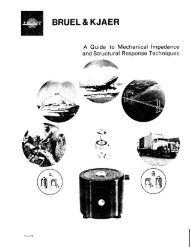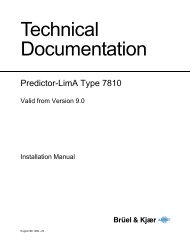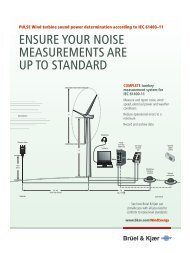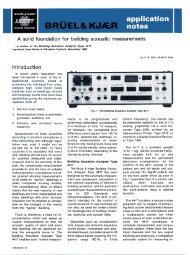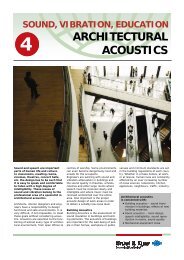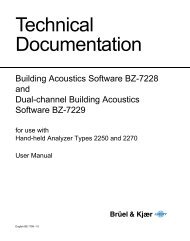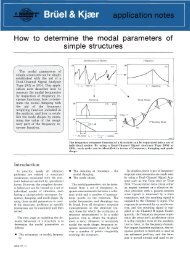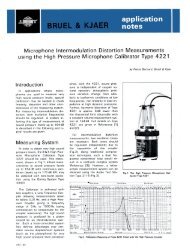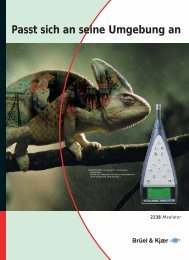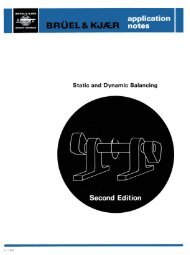Case Study: the Royal norwegian Navy Underwater Acoustic Noise ...
Case Study: the Royal norwegian Navy Underwater Acoustic Noise ...
Case Study: the Royal norwegian Navy Underwater Acoustic Noise ...
Create successful ePaper yourself
Turn your PDF publications into a flip-book with our unique Google optimized e-Paper software.
CASE STUDY<br />
The <strong>Royal</strong> Norwegian <strong>Navy</strong><br />
<strong>Underwater</strong> <strong>Acoustic</strong> <strong>Noise</strong> Measurement of Vessels<br />
The acoustic range at Heggernes, near Bergen, is used for measuring noise from all types of NATO naval<br />
vessels. Some civilian owned ships are also tested. The range, which commenced operating in 1994, is one<br />
of only few in <strong>the</strong> world and is run as a cooperation between Norway, The Ne<strong>the</strong>rlands and Germany.<br />
The equipment used for testing must be totally accurate and reliable – Brüel & Kjær products were chosen<br />
for <strong>the</strong>ir accuracy, ease of use and reliability, and <strong>the</strong> acoustic range uses a wide variety of Brüel & Kjær<br />
products including a PULSE Multi-analyzer, o<strong>the</strong>r types of analyzers, customised software, power and<br />
conditioning amplifiers, sound level meters and transducers.<br />
History<br />
Norway<br />
Defence<br />
<strong>Underwater</strong> <strong>Acoustic</strong>s, PULSE <br />
Early in <strong>the</strong> 1990s, <strong>the</strong> navies of Germany, Norway and The Ne<strong>the</strong>rlands entered into a<br />
cooperation agreement to establish an underwater acoustic range. Several locations<br />
were considered according to a number of criteria. Heggernes near Bergen was chosen<br />
and <strong>the</strong> station commenced operating in 1994.
Operation<br />
Fig. 1<br />
The control<br />
building for <strong>the</strong><br />
underwater<br />
acoustic range at<br />
Heggernes. The<br />
radar system has a<br />
range of 25 nm.<br />
Wea<strong>the</strong>r data is<br />
also available<br />
<strong>Acoustic</strong> Ranging<br />
Fig. 2<br />
The chart of <strong>the</strong><br />
range area. A<br />
number of<br />
hydrophones are<br />
located in <strong>the</strong><br />
dynamic and static<br />
ranges<br />
2<br />
The Material Command of The <strong>Royal</strong> Norwegian <strong>Navy</strong> has overall responsibility for <strong>the</strong><br />
operation and maintenance of <strong>the</strong> station.<br />
It also has responsibility for<br />
testing <strong>the</strong> vessels of <strong>the</strong> <strong>Royal</strong><br />
Danish and <strong>Royal</strong> Norwegian<br />
navies. The Dutch and German<br />
navies are responsible for carrying<br />
out <strong>the</strong>ir own acoustic<br />
ranging. The responsible authority<br />
in The Ne<strong>the</strong>rlands is<br />
<strong>the</strong> Naval Electronics and Optics<br />
Establishment (MEOB).<br />
The Wehrtechnische Dienststelle<br />
für Schiffe und Mainewaffen<br />
(WTD71) is responsible<br />
for German testing.<br />
Separate computers, with removable hard disks, are used by each country. Postprocessing<br />
of data on Norwegian vessels is made at Heggernes, while <strong>the</strong> data on<br />
German and Dutch vessels is made in <strong>the</strong>ir respective countries. Data is archived on<br />
magnetic tape.<br />
The naval vessels of o<strong>the</strong>r countries, and some civilan vessels are also occasionally<br />
tested. This is dependent upon <strong>the</strong> facilities being available, and <strong>the</strong> approval of <strong>the</strong><br />
testing.<br />
A committee comprising representatives of The Defence Ministries of Germany, The<br />
Ne<strong>the</strong>rlands and Norway meets annually to set out <strong>the</strong> principle guidelines for operation<br />
of <strong>the</strong> station.
Static Ranging<br />
Dynamic Ranging<br />
Fig. 3<br />
The view from <strong>the</strong><br />
office window! The<br />
ferry M/S Nordlys is<br />
passing <strong>the</strong><br />
Heggernes range<br />
The purpose of acoustic ranging is to measure <strong>the</strong> noise generated by vessels at various<br />
speeds. A vessel’s acoustic signature is most important for its function in military operations.<br />
<strong>Noise</strong> ranging is performed, for example, after major maintenance work, modifications<br />
or <strong>the</strong> installation of new equipment, in order to reveal any changes in <strong>the</strong><br />
noise levels of <strong>the</strong> vessel. New vessels are measured to ensure that <strong>the</strong> noise levels are<br />
within <strong>the</strong> limits stipulated in <strong>the</strong> building specifications, and that <strong>the</strong>y are in accordance<br />
with NATO requirements. It is also important to check that new vessels of <strong>the</strong> same<br />
class have nearly identical acoustic signatures. Both <strong>the</strong> static and dynamic ranging of<br />
vessels are carried out at Heggernes.<br />
Lt. Cdr. Harald Tholo, <strong>Royal</strong> Norwegian <strong>Navy</strong>, explains, “It’s a very great advantage to<br />
have a 400 m deep fjord. There are less reflections from <strong>the</strong> seabed and <strong>the</strong>refore<br />
Heggernes is an ideal site for our work.”<br />
Static ranging is carried out by mooring <strong>the</strong> vessel between three buoys in <strong>the</strong> static<br />
range. Two hydrophones (underwater acoustic transducers) are attached to <strong>the</strong> seabed<br />
(about 50 m below <strong>the</strong> surface), one on each side of <strong>the</strong> vessel. The water is deep<br />
enough to allow submarines to submerge while moored. The hydrophones are connected<br />
to <strong>the</strong> range house by 2 000 metre cables. A telephone line is also installed for voice<br />
communication with <strong>the</strong> moored vessel.<br />
To perform <strong>the</strong> tests, <strong>the</strong> various units on board <strong>the</strong> vessel (pumps, blowers, fans,<br />
generators, air conditioning, etc.) are started in turn and <strong>the</strong> noise <strong>the</strong>y produce is<br />
measured.<br />
Dynamic ranging is carried out by means of <strong>the</strong> vessel following a particular course.<br />
The noise from <strong>the</strong> vessel is analysed when it passes a specific point on <strong>the</strong> course,<br />
referred to as <strong>the</strong> closest point of approach (CPA). Five hydrophones are used – one is<br />
anchored to <strong>the</strong> seabed; <strong>the</strong> o<strong>the</strong>r four are in banks of two and <strong>the</strong>ir height below <strong>the</strong><br />
surface can be altered as required using a hydraulic winch. For surface vessels <strong>the</strong><br />
upper pair of hydrophones are set to a depth of about 20 m below <strong>the</strong> surface while<br />
<strong>the</strong> lower hydrophones are at about 90 meters. The hydrophones are connected to <strong>the</strong><br />
range house by 1 500 metre long cables.<br />
Lt. Cdr. Tholo explains, “The<br />
signal-to-noise ratio decreases<br />
if <strong>the</strong> hydrophones are too far<br />
away from <strong>the</strong> noise source<br />
and <strong>the</strong> background noise must<br />
be at least 6 dB below <strong>the</strong><br />
source.”<br />
Although <strong>the</strong> dynamic test range is in “public” water, <strong>the</strong> Police and Coastguard ensure<br />
that o<strong>the</strong>r vessels are excluded from <strong>the</strong> area when testing takes place.<br />
3
Highly Trained Experts<br />
Fig. 4<br />
Left to right:<br />
Lt. Cdr. Harald<br />
Tholo, Kjell<br />
Johansen, Erling<br />
Minde<br />
Equipment<br />
Fig. 5<br />
Just a part of <strong>the</strong><br />
impressive range of<br />
state-of-<strong>the</strong> art<br />
equipment<br />
available<br />
4<br />
It is important that <strong>the</strong> position of <strong>the</strong> vessel and any deviation relative to <strong>the</strong> positions<br />
of <strong>the</strong> measuring hydrophones are correct because loss of noise energy from <strong>the</strong> vessel<br />
to <strong>the</strong> hydrophones must be calculated in <strong>the</strong> analysis. Therefore, surface and underwater<br />
tracking systems have been installed which can determine <strong>the</strong> position of <strong>the</strong><br />
vessel to be measured at any particular time.<br />
The GPS (Global Position System) can fix <strong>the</strong> position of a vessel with an accuracy of<br />
about 2 metres. The position of a submerged submarine is determined by sonar. Voice<br />
communication with <strong>the</strong> vessel is ei<strong>the</strong>r by a secure digital radio link or, to submarines,<br />
by underwater telephone. These systems make it possible for <strong>the</strong> acoustic range to<br />
have continual control over <strong>the</strong> location of <strong>the</strong> vessel at all times.<br />
The range house at Heggernes has a<br />
wide variety of Brüel & Kjær equipment<br />
including:<br />
❍ 4-channel PULSE Multi-analyzer<br />
❍ Types 2131 and 2133 Analyzers<br />
❍ Type 2720 Power Amplifiers<br />
❍ Types 2306 and 2307 Level<br />
Recorders<br />
❍ Type 2625 Vibration Pick-up<br />
Amplifier<br />
❍ Type 2628 LF Charge Amplifiers<br />
❍ Type 2650 Precision Conditioning<br />
Amplifiers<br />
❍ Type 2033 FFT Analyzer<br />
❍ Type 5619 Channel Selector<br />
❍ Sound Level Meters<br />
The permanent staff of <strong>the</strong> Heggernes<br />
range have unique experience and training<br />
in underwater acoustics.<br />
Lt. Cdr. Harald Tholo has a degree in hydroacoustics.<br />
He continued his studies at<br />
<strong>the</strong> <strong>Royal</strong> Norwegian Naval Academy and<br />
joined <strong>the</strong> <strong>Navy</strong> in 1985.<br />
Kjell Johnsen is an engineer and specialises<br />
in acoustics and sonar. He joined The<br />
<strong>Royal</strong> Norwegian <strong>Navy</strong> in 1988.<br />
Erling Minde is an acoustic measurement<br />
specialist and joined The <strong>Royal</strong> Norwegian<br />
<strong>Navy</strong> in 1986.
Measurements<br />
Fig. 6<br />
A typical PULSE <br />
display showing 2channel<br />
FFT<br />
analysis graphs and<br />
contour plots<br />
Brüel & Kjær hydrophones are also used at <strong>the</strong> <strong>Royal</strong> Norwegian <strong>Navy</strong>’s base at Bergen.<br />
As can be seen in Fig. 5, <strong>the</strong> Heggernes facility boasts a large amount of <strong>the</strong> latest “hightech”<br />
equipment.<br />
The height of <strong>the</strong> hydrophones is controlled using <strong>the</strong> SIMRAD hydrophone system.<br />
Kjell Johansen says, “Our latest acquisition is 31 foot twin-screw launch which we will<br />
use to visit <strong>the</strong> vessels being tested.”<br />
Lt. Cdr. Harald Tholo explains,<br />
“We follow <strong>the</strong> established<br />
NATO Standards for acoustic<br />
ranging.”<br />
Kjell Johansen says, “The<br />
PULSE software has been customised<br />
and <strong>the</strong> data collection<br />
process is highly automated.<br />
Frequency corrections for accurate<br />
calibration values of <strong>the</strong><br />
hydrophones and distance correction<br />
calculations are made.”<br />
The vessel being tested normally makes four test-runs – two east and two west. The<br />
results from <strong>the</strong> four runs are correlated. The data is posted back into <strong>the</strong> PULSE <br />
system.<br />
Kjell continues, “We use FFT analysis extensively and all <strong>the</strong> computers run under<br />
Windows NT ® ”. Erling adds, “We calibrate <strong>the</strong> cables and preamplifiers before and after<br />
every test run. The calibration is made using sine waves, and both white and pink noise.<br />
He continues, “We only calibrate <strong>the</strong> hydrophones once a year as our experience shows<br />
that <strong>the</strong>y do not go out of specification.”<br />
Reports are made in a standard military format using Microsoft ® Word.<br />
Accurate<br />
Lt. Cdr. Harald Tholo explains, “We chose Brüel & Kjær because <strong>the</strong>ir products are<br />
accurate, easy to handle and <strong>the</strong> company has an excellent reputation. We get excellent<br />
support, service and training.” Kjell adds, “We are often in discussions with shipbuilders<br />
when we measure against <strong>the</strong> design specifications. When we tell <strong>the</strong>m that we use<br />
Brüel & Kjær, <strong>the</strong>re are no discussions concerning <strong>the</strong> accuracy of <strong>the</strong> data.”<br />
5
A Practical Example<br />
Fig. 7<br />
The graphs shows<br />
<strong>the</strong> underwater<br />
acoustic<br />
frequencies<br />
generated by <strong>the</strong><br />
ship’s two<br />
propellers plotted<br />
against <strong>the</strong> sound<br />
pressure level in dB<br />
Key Facts<br />
HEADQUARTERS: DK-2850 Nærum · Denmark · Telephone: +45 4580 0500 · Fax: +45 4580 1405 · www.bksv.com · info@bksv.com<br />
Australia (+61) 2 9889-8888 · Austria (+43) 1 865 74 00 · Brazil (+55)11 5188-8166 · Canada (+1) 514 695-8225<br />
China (+86) 10 680 29906 · Czech Republic (+420) 2 6702 1100 · Finland (+358) 9-755 950 · France (+33) 1 69 90 71 00<br />
Germany (+49) 421 17 87 0 · Hong Kong (+852) 2548 7486 · Hungary (+36) 1 215 83 05 · Ireland (+353) 1 807 4083<br />
Italy (+39) 0257 68061 · Japan (+81) 3 5715 1612 · Republic of Korea (+82) 2 3473 0605 · Ne<strong>the</strong>rlands (+31)318 55 9290<br />
Norway (+47) 66 77 11 55 · Poland (+48) 22 816 75 56 · Portugal (+351) 21 47 11 4 53 · Singapore (+65) 377 4512<br />
Slovak Republic (+421) 25 443 0701 · Spain (+34) 91 659 0820 · Sweden (+46) 8 449 8600 · Switzerland (+41) 1 880 7035<br />
Taiwan (+886) 2 2502 7255 · United Kingdom (+44) 14 38 739 000 · USA (+1) 800 332 2040<br />
Local representatives and service organisations worldwide<br />
Much of <strong>the</strong> work carried out on naval vessels at<br />
<strong>the</strong> Heggernes range is secret. However, o<strong>the</strong>r ships<br />
pass <strong>the</strong> range and <strong>the</strong> ferry M/S Nordlys (11 200<br />
tonnes, built in 1994) is a frequent visitor. To illustrate<br />
one aspect of <strong>the</strong> use of <strong>the</strong> underwater noise<br />
measurement system, <strong>the</strong> ship’s noise signature was<br />
monitored using <strong>the</strong> submerged hydrophones on<br />
<strong>the</strong> dynamic range and fed, via conditioning amplifiers,<br />
into two channels of <strong>the</strong> Type 2133 analyzer.<br />
The program reads <strong>the</strong> data once per second and<br />
makes an average of <strong>the</strong> spectra. From this, a plot<br />
of <strong>the</strong> 1/3-octave analysis can be made, as shown<br />
in <strong>the</strong> illustration. On <strong>the</strong> x- axis <strong>the</strong> graph displays<br />
<strong>the</strong> acoustic frequencies generated by each of <strong>the</strong><br />
ship’s two propellers. The y- axis shows <strong>the</strong> sound<br />
pressure level in decibels related to 1µPa and corrected<br />
for bandwidth to 1 Hz. A printed copy of <strong>the</strong><br />
graph can be made displaying <strong>the</strong> spectra as a level<br />
function of frequency as shown in Fig. 7.<br />
❍ Early in <strong>the</strong> 1990s, <strong>the</strong> navies of Germany, Norway and The Ne<strong>the</strong>rlands entered into<br />
a cooperation agreement to establish an underwater acoustic range<br />
❍ The acoustic range at Heggernes, near Bergen, is used for measuring noise from all<br />
types of NATO naval vessels<br />
❍ <strong>Acoustic</strong> ranging is used to measure <strong>the</strong> noise generated by vessels at various speeds<br />
❍ The permanent staff at <strong>the</strong> Heggernes range are a highly trained team of experts<br />
❍ The acoustic range uses a wide variety of Brüel & Kjær products including PULSE ,<br />
o<strong>the</strong>r multi-analyzers, customised software, power and conditioning amplifiers, sound<br />
level meters and transducers<br />
❍ FFT analysis is used extensively<br />
❍ The <strong>Royal</strong> Norwegian <strong>Navy</strong> chose Brüel & Kjær because <strong>the</strong>ir products are reliable,<br />
accurate, easy to handle and <strong>the</strong> company has an excellent reputation<br />
❍ The <strong>Royal</strong> Norwegian <strong>Navy</strong> get excellent support, service and training<br />
BO 0487−12 04/09





